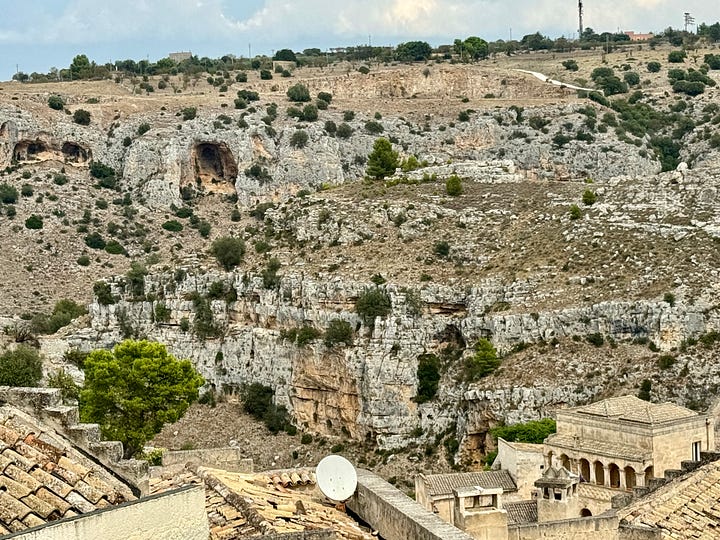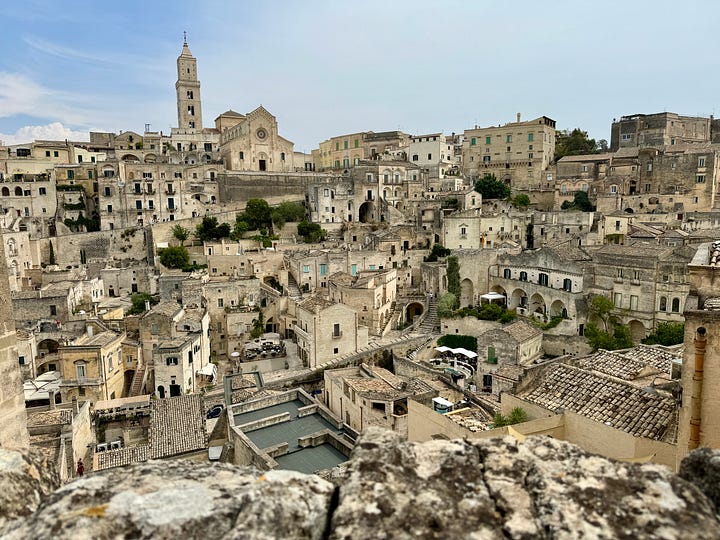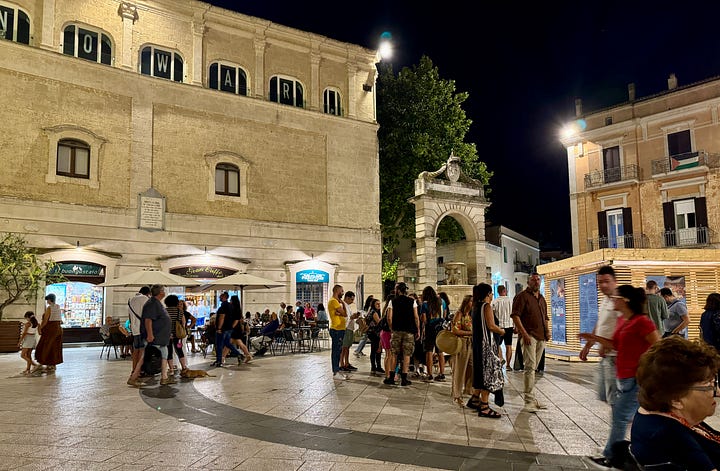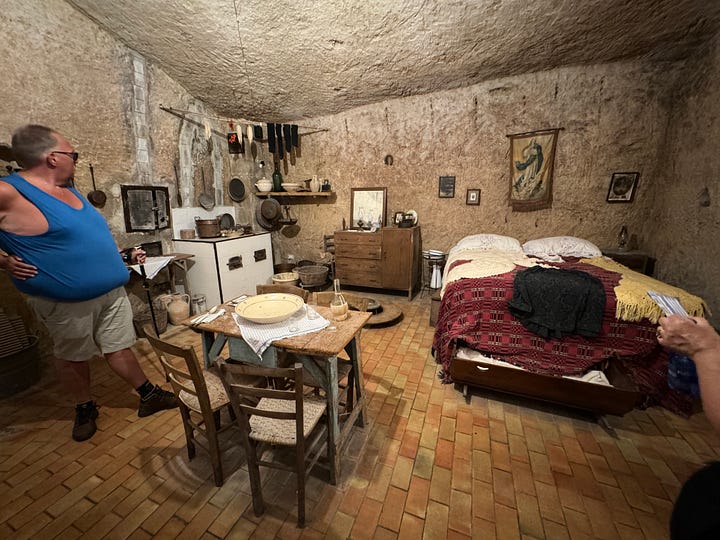I’ve Fallen in Love with an Italian Beauty
Her name is Matera. I just spent two weeks with her, and I can’t wait to be in her arms again.




Family and friends,
To those of you who know the Beloved1 and me, you may be especially shocked. However, before you ostracize me as an old lothorio, let me explain.
You will be relieved to know that I’ve come clean with the Beloved1. She knows all about Matera. She loves her, too. (No, we’re not a ménage a trois.) When I declared my ardor, the Beloved1 wasn’t the least bit jealous. You see, I didn’t take to Matera as the younger woman. In fact, Matera is older than Sophia Loren. Way older. Like more than 9,900 years older.
Matera is a city — a clean bustling comune of 60,000. What makes Matera so fetching is that she’s a beguiling blend of old and new. Antiquity strolls with modernity there. She’s one of Europe longest occupied places, first inhabited by Stone Age peoples who moved into the caves in the two sheer, facing limestone cliffs astride a river that blossoms Into a flatland. With time, its Iron and Bronze-age people began carving homes into the cliffs. They used limestone from the nearby quarries to build churches and other building in the river bottom known collectively as the Sassi.
You can look down into the old city — a distinct bleach-bone bowl — and descend into it by numerous steep stone stairs to visit a “stone house” recreated with the a kitchen-bedroom and a loft where its earlier dwellers ago kept their animals.
Eventually, the Sassi’s mercantile class began migrating up and out onto the overlooking plateau, while still using the caves below to store water, grain, livestock, and olive mills that fueled lamps throughout Europe. We enjoyed a highly engaging historical multimedia tour name that takes place in the caves beneath one of the city’s grand palazzos — well worth the 10 Euro senior admission price.
What may even more amazing about Matera is how far its come from its recent past. During the 1950s, the Sassi became so poverty stricken as to become known as “Italy’s shame.” Think America’s Appalachia. Italy government decided to do something about it. It moved people out of their cave homes to the plateau where there began what today stands out as a miraculous modernization.
Now, a long pedestrian walkway wends its way around the upper city and down into the Sassi, lined with dozens of shops — many high-end — bars and restaurants. Even in September, each and every day of our visit the passeggiata was crammed with tourists, Italians, and families. Cars and scooters were rare among us — as it should be a more cities.
Ah, and the food! In no other city in four trips to Italy had I eaten as well — and at such reasonable prices. We feasted on the local Pane di Matera, a knotty, thick-crusted bread made from Basilicata’s ancient grains. If there, you have to try two uniquely local dishes. One is called La Pignata, a crock of mutton, potatoes, carrots, in a light broth and covered with beautifully crusted dough dome. The other is the most unfortunately named crapiata, which is anything but. It’s made of beans, vegetables and carrots, and it’s a common-person’s dish. However, I had a delightful reinterpretation by the chef Giancarlo at his Basquiat Il Restaurantino.
Unlike such tourist destinations as Amalfi, Matera offered great shopping too. I picked up some nice jeans and shirts on sale, each item for under $35 Euros.
It’s beyond me how Matera sustain’s so many restaurants and shops but clearly it does.
Talk about convenient. We rented a very moderne AirBnB on the periphery of the city’s central core. We could walk out the door into coffee shops, delis, a nicely stocked market, and a square lined with fresh fruit, veggies, meat, cheese, and fish vendors. You really don’t need a car to get the most out of Matera and its home region of Basilicata.
I simply can’t say enough good things about my Italian lovely — clean, safe, reasonably priced, cultured, energetic, and thriving. As proof of her virtues, the city was named a UNESCO World Heritage Site and a European Capital of Culture. She’s since been called Italy’s hidden gem and its rock star.
Now that you know whole story, I hope you’ll understand why my heart’s been stolen.
Although we didn’t have a bad meal anywhere in Matera, these five restaurants topped our list:
Era Convivial. Highly rated restaurant built into one of the Sassi caves. The walls were are white as the freshly pressed tablecloths. The Beloved1 and I had a grotto table to ourselves — very romantic. I had the orichette in a Lucanian black (braised) pork ragu. Comfort food!
Basquiat Il Ristorantino. When we called for a reservations, we had a translation issue with the chef and owner, Giancarlo. When we got there for our 7 p.m. table we were told, rudely, that it wasn’t open until 8. We decided to give it another chance. Good thing we did. We not only had a scrumptious lunch, we went back for dinner. Make sure you order the crapiatia, served with a moist, flaky hunk of dried cod, aka bacala. Giancarlo raises this common and traditional dish to haute cuisine.
AnticaTrattoria Lucana. Have the involtini di melanzane (eggplant rolls with ricotta cheese) and the house tomato sauce. In fact, have anything that has the house sauce. Best I’ve tasted anywhere in Italy or the U.S.
La Gattabuia. We found this highly recommended restaurant but only after we stopped by its next door wine shop for a tasting of noted Basilicata varietals. The owner, Stefano, was excellent, and treated us like celebs when we showed up for dinner the next night. Fine dining at a reasonable price.
Osteria La Pignata. You have to go there for the signature Lucanian dish, la pignata — a pot pie. There’s a small one made with lamb, which we had on our first night. We went back for a second night where I had the big one made with mutton. Comfort food, and a dish you won’t get elsewhere.
Honorable mentions: Il Falco Grillaio for its fior di zucca (fried zucchini flowers) which were the best we’ve eaten at home, in the U.S., or elsewhere in Italy, Capatosta for its traditional rendition of the bean and potato stew, la crapiata.





She stole mine too 🤩 It must have been the combination of history with soul that brought me there from Puglia last year, and... what a difference! Less olive fields and yet full of charm. The picture of the stone house looks like that same I entered... 😉
thanks for the nice account of Matera. Want to go there since a while. I noted down your restaurant recommendations. Thanks for sharing them.